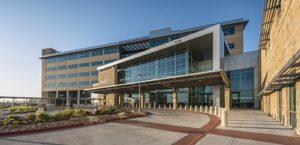Subscribe Now
Dignitaries Cut Ribbon at Official Opening for Carl R. Darnall Army Medical Center
FORT HOOD, TEXAS — U.S. Rep. John Carter, R-Round Rock, joined Deputy Under Secretary of Defense John Conger, local leaders and Fort Hood leadership in cutting the ribbon recently to signify the new Carl R. Darnall Army Medical Center is officially open for business in Fort Hood, Texas.
 The 947,000-square-foot Carl R. Darnall Army Medical Center – one of the largest medical centers in the Department of Defense inventory – is nearly 60 percent larger than the original facility and includes a six-story hospital, three outpatient clinic buildings and three parking garages.
The 947,000-square-foot Carl R. Darnall Army Medical Center – one of the largest medical centers in the Department of Defense inventory – is nearly 60 percent larger than the original facility and includes a six-story hospital, three outpatient clinic buildings and three parking garages.
It is the largest Department of Defense contract funded by the American Recovery and Reinvestment Act, also known as the stimulus package. According to Major General John Uberti, deputy commanding general, III, Corps and Fort Hood, it is the last project completed under the American Recovery Act.
The replacement hospital – designed and built by the Balfour Beatty | McCarthy | HKS & Wingler & Sharp Design-Build team – seeks to reflect on “What Makes the Army Strong” to provide the best medical care possible.
The U.S. Army Corps of Engineers’ objective with the new Carl R. Darnall Army Medical Center was simple: Ensure soldiers and their families were offered the best of care prior to and following deployment. The medical center reinforces and promotes Fort Hood’s mission of providing world-class healthcare within a state-of-the-art, innovative and truly modern healing environment.
The medical center’s division of services, defined as portals of care, is mainly categorized as clinic-based or hospital-based. While there are many service lines, there is a focus on women’s services, orthopedic services and behavioral health services. Major clinic-based portals of care contain primary and comprehensive departments, which include primary care, orthopedics and rehabilitation, women’s outpatient services, emergency medicine, disability evaluation, surgery and multiple outpatient behavioral health clinics.
The exterior design is simple and appealing — promoting efficiency in design and construction, and establishing a desirable healing environment.
The medical center evokes Fort Hood pride — responding to and reflecting upon local geographical features such as topography, natural materials, rock formations, plateaus and ridges, wetlands and lakes, vegetation and wooded areas. Local materials — such as Texas limestone — are incorporated into the façade in conjunction with organic landscaping, healing gardens and shaded areas to promote outdoor activities. External sunshades are utilized in conjunction with extensive glazing to maximize daylighting and borrowed light while minimizing glare, internal heat load and the need for artificial lighting at perimeter spaces. Rooftop gardens, terraces and vegetated roofs are incorporated to improve patient views, roof insulation and the loads on HVAC. Precast insulated panels incorporating thin brick and stone are manufactured locally to high quality standards and are installed quickly, contributing to a cost-effective and appealing façade.
Central to the design is an enclosed courtyard with a memorial garden dedicated to Brig. Gen. Carl Rogers Darnall. Darnall discovered the value of using compressed liquefied chlorine gas to purify water for use by troops in the field. His 1910 invention, the mechanical liquid chlorine purifier (chlorinator), is now used throughout the world. This monumental discovery was later applied to municipal water supplies. His legacy is illustrated in the courtyard area, including an active water feature that cascades down the memorial walls to honor his achievement and emulate a Texas river.
Not many buildings are designed specifically to be in service 60 years from now. But this is the case for the Carl R. Darnall Army Medical Center. This building is not just an expenditure; it’s an investment for the U.S. Army Corps of Engineers. To make it last, the Design-Build team looked at durability, flexibility and adaptability.
Tags: Construction, Department of Defense
Posted July 5, 2016
More Articles:
- CxA Workshop & Exam
Apr 29, 2024 – Apr 30, 2024 - EMP Seminar & Exam at CxEnergy 2024
Apr 29, 2024 – Apr 30, 2024 - CxEnergy
Apr 29, 2024 – May 2, 2024 - PHCC West 2024
Apr 29, 2024 – May 2, 2024 - Lean in Design Forum 2024
May 1, 2024 – May 2, 2024 - IFMA’s Facility Fusion Conference & Expo
May 5, 2024 – May 7, 2024 - ASHE Academy 2024
May 6, 2024 – May 10, 2024










